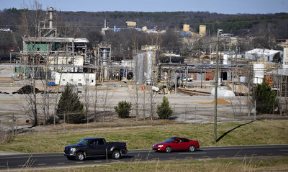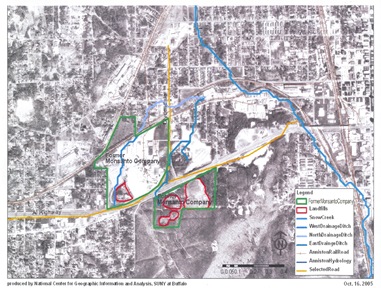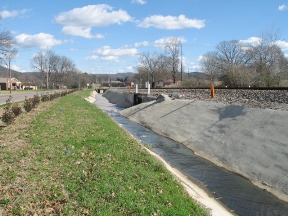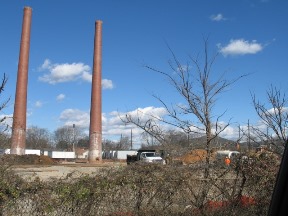Overview

Figure 1: Current chemical production
facilities on the site of former
Monsanto PCB plant (now owned
by Eastman Corporation).
Photo: Anniston Star
From 1929 to 1971, polychlorinated biphenyls (PCBs) were manufactured at an industrial facility formerly owned and operated by the Swann Chemical Company (1929-1935) and after 1935 by Monsanto Chemical Corporation in Anniston, Alabama. Releases of PCBs into the air and water by volatilization, deposition into landfills, and migration into surface water led to substantial environmental contamination, human exposure and community health concerns, and ultimately litigation and settlement in state and federal court (Grunwald, 2001external icon; Love, 2007). The chemical plant continued to produce other chemicals and was owned and operated by Solutia, Inc., since 1997. It was recently acquired by Eastman Chemical Company.external icon Prior to 1971, when Monsanto ceased manufacture of PCBs in Anniston, there were no federal or state regulations governing the manufacture, sale, distribution or disposal of PCBs.
 image icon[JPG - 3 MB]
image icon[JPG - 3 MB](click to view larger image)
Figure 2: Satellite image of Anniston,
Alabama, with the former PCB
production facilities, landfills, and
waterways indicated in color.
In the 1990s and early 2000s, several investigations of exposure documented elevated levels of PCBs in some Anniston residents and in air and soil samples from the local environment (ADPH, 1996 pdf icon[PDF – 1.19 MB]external icon; ATSDR, 2000). During the same time, extensive measures to prevent further spread of PCBs in Anniston and environmental cleanup of residential and other properties were undertaken by Monsanto and Solutia under the supervision of the Alabama Department of Environmental Management (ADEM) and the US EPA as part of the series of consent decrees mostly under Resource Conservation and Recovery Act (RCRA; the EPA Anniston websiteexternal icon).
From 2003 to 2007, the ATSDR funded the Anniston Environmental Health Research Consortium (AEHRC), a university and community partnership charged to plan and conduct the 2005-2007 Anniston Community Health Survey (ACHS) through a cooperative agreement with Jacksonville State University (Grant #U50/ATU473215). The study Institutional Review Board (IRB) approval was obtained at the University of Alabama at Birmingham.

Figure 3: East draining ditch from
the former PCB production facility
(paved during PCB clean-up efforts
in late 1990s).
Eating contaminated food products, especially fish and livestock, is the most important pathway of PCB exposure in people who have not been occupationally exposed to PCBs (Hovinga et al., 1992; Humphrey and Budd, 1996; Kreiss, 1981; Schecter et al., 2001; Startin et al., 1994). Exposures by way of inhalation and contact with the skin have also been studied (DeCaprio et al., 2005; Löffler and van Bavel, 2000), but exposures through these pathways generally contribute much less to the body burden than does exposure by eating contaminated food. In Anniston, records of high PCB contamination of locally raised hogs, chickens and other animals were presented during litigation (Chemical Industry Archives, 2001; Love, 2007). Local fish have been found to be contaminated above the U.S. Food and Drug Administration’s published tolerance of 2 parts per million (edible portion) (21CFR109.30external icon, 2012). As a result, “no consumption” fish advisories were issued in Anniston in the 1990s that are now still in effect (ADPH, 1995 pdf icon[PDF – 2 MB]external icon, 1996 pdf icon[PDF – 1.19 MB]external icon, 2011external icon).
Results from human health studies of environmental PCB exposure outside of Anniston provide some evidence of associations between PCB serum levels and a variety of health outcomes, including diabetes and its precursors (Codru et al., 2007; Langer et al., 2002; Lee et al., 2007, 2011; Rylander et al., 2005; Vasiliu et al., 2006; Wang et al., 2005), hypertension (Everett et al., 2008; Ha et al., 2009), adverse thyroid and metabolic health signs (Langer et al., 2009; Persky et al., 2001; Turyk et al., 2007), immune system effects (Heilman et al., 2006; Park et al., 2008), and some cancers (DeRoos et al., 2005; Hardell et al., 2004). (ATSDR has updated the Toxicological Profile for PCBs with more recent findings on health effects pdf icon[PDF – 1.29 MB].)

Figure 4: Remnants of one of
former foundries and pipe
production facilities in west
Anniston.
Elevated levels of PCBs were found in ACHS participants in comparison to the general public. When compared with similar age and race groups reported from the National Health and Nutrition Examination Survey (NHANES) 2003-2004, PCB levels in Anniston were about three times higher for African-American participants and two times higher for White participants age 40 or older (Pavuk et al., 2014external icon; Patterson et al., 2009).
Results from the ACHS generally support findings in other health studies, showing associations between levels of PCBs in study participants’ blood and hypertension, blood pressure, and diabetes (Goncharov et al., 2010 pdf icon[PDF – 201 KB], 2011 pdf icon[PDF – 411 KB]external icon; Silverstone et al., 2012 pdf icon[PDF – 316 KB]external icon).
Chemical Industry Archives, Environmental Working Group, 2001. Trial Transcript, Owens v. Monsanto CV-96-J-440-E, (N.D. Alabama April 5, 2001), pg. 551, line 1; a memo from E.S. Tucker to W.B. Papageorge, December 21, 1970 (both Monsanto, PCB results for hog’s liver and fat samples). http://www.chemicalindustryarchives.org/dirtysecrets/annistonindepth/wildlife.aspexternal icon. Accessed: February 15, 2013.
21 Code of Federal Regulations 109.30, 1 April 2012. “Tolerances for polychlorinated biphenyls (PCB’s).”
Codru, N., Schymura, M.J., Negoita, S., 2007. Diabetes in relation to serum levels of polychlorinated biphenyls and chlorinated pesticides in adult Native Americans. Environ. Health Perspect. 115(10), 1442-1447.
DeCaprio, A.P., Johnson, G.W., Tarbell, A.M., Carpenter, D.O., Chiarenzelli, J.R., Morse, G.S., Santiago-Rivera, A.L., Schymura, M.J., Akwesasne Task Force on the Environment, 2005. Polychlorinated biphenyl (PCB) exposure assessment by multivariate statistical analysis of serum congener profiles in an adult Native American population. Environ Res. 98(3), 284-302.
De Roos, A.M., Hartge, P., Lubin, J.H., Colt, J.S., Davis, S., Cerhan, J.R., Severson, R.K., Cozen, W., Patterson Jr., D.G., Needham, L.L., Rothman, N., 2005. Persistent organochlorine chemicals in plasma and risk of non-Hodgkin’s lymphoma. Cancer Res. 65(23), 11214-11226.
Everett, C.J., Mainous, A.G., Frithsen, I.L., Player, M.S., Matheson, E.M., 2008. Association of polychlorinated biphenyls with hypertension in the 1999-2002 National Health and Nutrition Examination Survey. Environ. Res. 108(1), 94-97.
Ha, M.H., Lee, D.H., Son, H.K., Park, S.K., Jacobs, D.R., 2009. Association between serum concentrations of persistent organic pollutants and prevalence of newly diagnosed hypertension: results from the National Health and Nutrition Examination Survey 1999–2002. J. Hum. Hypertens. 23, 274-286.
Hardell, L., van Bavel, B., Lindström, G., Carlberg, M., Eriksson, M., Dreifaldt, A.C., Wijkström, H., Starkhammar, H., Hallquist, A., Kolmert, T., 2004. Concentrations of polychlorinated biphenyls in blood and the risk for testicular cancer. Int. J. Androl. 27(5), 282-290.
Heilmann, C., Grandjean, P., Weihe, P., Nielsen, F., Budtz-Jørgensen, E., 2006. Reduced antibody responses to vaccinations in children exposed to polychlorinated biphenyls. PLoS Med. 3(8), 1352-1359.
Hovinga, M.E., Sowers, M., Humphrey, H.E., 1992. Historical changes in serum PCB and DDT levels in an environmentally-exposed cohort. Arch Environ Contam Toxicol. 22(4), 362-366.
Humphrey, H.E., Budd, M.L., 1996. Michigan’s fisheater cohorts: a prospective history of exposure. Toxicol. Ind. Health 12(3-4), 499-505.
Kreiss, K., Zack, M.M., Kimbrough, R.D., Needham, L.L., Smrek, A.L., Jones, B.T., 1981. Association of blood pressure and polychlorinated biphenyl levels. JAMA 245(24), 2505-2509.
Langer, P., Kočan, A., Tajtáková, M., Sušienková, K., Rádiková, Ž., Koška, J., Kšinantová, L., Imrich, R., Hučková, M., Drobná, B., Gašperíková, D., Trnovec, T., Klimeš, I., 2009. Multiple adverse thyroid and metabolic health signs in the population from the area heavily polluted by organochlorine cocktail (PCB, DDE, HCB, dioxin). Thyroid Res. 2(3).
Langer, P., Tajtáková, M., Guretzki, H.J., Kocan, A., Petrík, J., Chovancová, J., Drobná, B., Jursa, S., Pavúk, M., Trnovec, T., Seböková, E., Klimes, I., 2002. High prevalence of anti-glutamic acid decarboxylase (anti-GAD) antibodies in employees at a polychlorinated biphenyl production factory. Arch. Environ. Health 57(5), 412-415.
Lee, D.H., Lee, I.K., Jin, S.H., Steffes, M., Jacobs Jr., D.R., 2007. Association between serum concentrations of persistent organic pollutants and insulin resistance among nondiabetic adults: Results from the National Health and Nutrition Examination Survey 1999-2002. Diabetes Care 30(3), 622-628.
Lee, D.H., Lind, P.M., Jacobs Jr., D.R., Salihovic, S., van Bavel, B., Lind, L., 2011. Polychlorinated biphenyls and organochlorine pesticides in plasma predict development of type 2 diabetes in the elderly: the prospective investigation of the vasculature in Uppsala Seniors (PIVUS) study. Diabetes Care 34(8), 1778-1784.
Löffler, G., van Bavel, B., 2000. Potential pathways and exposure to explain the human body burden of organochlorine compounds: a multivariate statistical analysis of human monitoring in Würzburg, Germany. Chemosphere 40(9-11), 1075-1082.
Love, D., 2007. My City Was Gone: One American Town’s Toxic Secret, Its Angry Band of Locals, and a $700 Million Day in Court. Harper Perennial Publishers.
Park, H.Y., Hertz-Picciotto, I., Petrik, J., 2008. Prenatal PCB exposure and thymus size at birth in neonates in Eastern Slovakia. Environ. Health Perspect. 116(1), 104-109.
Patterson DG Jr, Wong LY, Turner WE, Caudill SP, Dipietro ES, McClure PC, Cash TP, Osterloh JD, Pirkle JL, Sampson EJ, Needham LL.. 2009. Levels in the U.S. population of those persistent organic pollutants (2003-2004) included in the Stockholm Convention or in other long range transboundary air pollution agreements. Environ Sci Technol. 2009 Feb 15;43(4):1211-8.
Persky, V., Turyk, M., Anderson, H.A., Hanrahan, L.P., Falk, C., Steenport, D.N., Chatterton Jr., R., Freels, S., Great Lakes Consortium, 2001. The effects of PCB exposure and fish consumption on endogenous hormones. Environ. Health Persp. 109, 1275-1283.
Rylander, L., Rignell-Hydborn, A., Hagmar, L., 2005. A cross-sectional study of the association between persistent organochlorine pollutants and diabetes. Environ. Health 4, 28-33.
Schecter, A., Cramer, P., Boggess, K., Stanley, J., Päpke, O., Olson, J., Silver, A., Schmitz, M., 2001. Intake of dioxins and related compounds from food in the US population. J. Toxicol. Environ. Health A 63, 101–118.
Startin, J.R., 1994. Dioxins in food, in: Schecter, A. (Ed.), Dioxins and Health. Plenum Press, New York, pp. 115–137.
Turyk, M.E., Anderson, H.A., Persky, V.W., 2007. Relationships of thyroid hormones with polychlorinated biphenyls, dioxins, furans, and DDE in adults. Environ. Health Persp. 115, 1197-1203.
Vasiliu, O., Cameron, L., Gardiner, J., Deguire, P., Karmaus, W., 2006. Polybromated biphenyls, polychlorinated biphenyls, body weight, and incidence of adult-onset diabetes mellitus. Epidemiology 17(4), 352-359.
Wang, S-L., Su, P-H., Jong, S-B., Guo, Y.L., Chou, W-L., Päpke, O., 2005. In utero exposure to dioxins and polychlorinated biphenyls and its relations to thyroid function and growth hormone in newborns. Environ. Health Perspect. 113(11), 1645-1650.